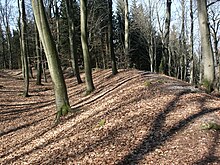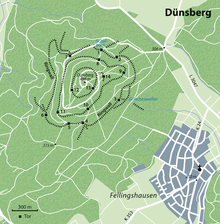Dünsberg ring wall
The ring wall Dünsberg is about 90 hectares large Iron Age Oppidum on the Dünsberg at Wetzlar and casting , defined by three powerful ringwalls was attached. Since 1999 regular research excavations by the Roman-Germanic Commission and the Dünsberg-Verein Archäologie im Gleiberger Land e. V. instead. Parts of the complex, including a reconstructed gate, are now an open-air museum.
location
With its characteristic silhouette and a height of 498 meters, the Dünsberg forms a clear landmark about eleven kilometers northeast of Wetzlar and about nine kilometers northwest of Gießen. It dominates the Lahn valley and enables the access to the settlement-favorable Wetterau to be controlled from the north. The ring wall is located on the top of the mountain. The relatively steep slopes were also inhabited during the Iron Age. In addition to its strategic importance, the Dünsberg was also of economic importance due to iron ore deposits.
Research history
As early as 1730 Johann Georg Liebknecht published a work on the history of Hesse, in which the ground monuments of the Dünsberg are mentioned for the first time, along with a description of Roman coins found: "Because of its old monuments ... the Dünsberg is unique in Hesse."
From the 18th century, more and more metal finds became known. The local estate and forest owner A. van der Hoop owned what is probably the most extensive private collection. Having become aware of this, the first systematic excavations were carried out between 1903 and 1906 by Emil Ritterling, the director of the State Museum of Nassau Antiquities in Wiesbaden . On behalf of the Reich Limes Commission, Ritterling laid cuts through the ramparts and discovered a Celtic spring socket made of wood at Schulborn. Ritterling's successor Eduard Brenner continued the exploration of the Dünsberg in 1912. But it was not until 1958 that Wolfgang Dehn presented the first comprehensive plan of the facility .
Further findings were uncovered during construction work in the 1960s and 1970s. In 1974 Fritz-Rudolf Herrmann from the State Office for Monument Preservation Hessen (LfDH) examined an area on the top of the mountain during the construction of the television tower. After the ring walls were measured by the Frankfurt University of Applied Sciences in 1984, the Hessian state parliament approved a special budget for research into the facility. But it wasn't until 1999 that the Roman-Germanic Commission began with the support of the specially founded Archeology Association in Gleiberger Land e. V. - also known as the Dünsberg Association -, under the direction of Karl F. Rittershofer with planned research excavations on the southern slope. These excavation campaigns continue to this day under the direction of Claudia Nickel.
investment

The summit of the Dünsberg is surrounded by three ring walls with pointed trenches in front, which are still over ten meters high today and enclose an approx. 90 hectare settlement area. A total of 14 gate openings have been identified through measurements so far, which have been numbered. On the steep slopes, the residents created podium-like terrace areas. In the time of the oppidum , these provided space for houses made of a wooden structure clad with clay.
The three ramparts probably did not exist at the same time. However, the sequence of the plant is still largely unclear. Findings on the southern slope indicate a fortified settlement from the 8th century BC. BC, so since the Late Bronze Age Urnfield Culture . In this early context, the inner fastening ring is counted. Characteristic fire residues speak for a system with a solid wood-earth wall . Most of the finds so far come from the 3rd century BC. This heyday was accompanied by an economic upswing due to the increased exploitation of iron ore deposits on the Dünsberg. The metal was smelted and processed on site. The middle ring wall may count in this phase. But only the outer wall could be based on wood finds in the time around 120/100 BC. Chr. Dendrodatiert be.
No wells are known within the complex. The oppidum was supplied with water via natural spring outlets that were framed with wooden basins. Two of these spring mountings , the Grinchesweiher and the Schulborn , have already been excavated by Ritterling. In 2003 the Schulborn was re-examined using modern methods. Dates on wood of the source version showed that the place since the 4th / 3rd Century BC Was used. After repairs in the late 2nd century BC The source enclosure was last used in the 1st century BC. Chr. Repaired.
Dating and population
Finds such as fibulae and stamp ceramics show that for the first time at the transition to the Middle Latene period, i.e. around the middle of the 3rd century BC Chr., An intensive settlement on the Dünsberg began. So far, there are no older metal finds. This intensive settlement ended in the second half of the first century BC. Chr.
Research is discussing the residents of the ring wall and the oppidum . On the basis of numismatic investigations on found coins, in particular the development of the coinage of the “ Dancing Man ” type, a migration of the Dünsberg population into the Cologne area in the 3rd decade of the 1st century BC is assumed. Adopted. This migration movement corresponds with the tribal history of the Ubier , so that the Dünsberg is viewed by research as the central location of the Ubier before this 19/18 BC. Were resettled by Agrippa in the Rhineland. It is significant that the series of coins from the “Dancing Male”, probably struck on the Dünsberg, dates back to 20 BC. On the oppidum tears off. More recent coins can now be found in the Rhineland, in the Lippelager and in the Waldgirmes site until after the turn of the century, with slight deviations in the motif and, in some cases, declining quality .
However, this assignment to the Ubi tribe is controversial. Critics of the Ubier thesis claim that the complex on the Dünsberg is a typical Celtic settlement, which Gaius Iulius Caesar described Ubier as a Germanic. Caesar also proved that the Ubier possessed oppida.
Finds and Findings
The problem with the evaluation of the finds from the Dünsberg is that most of the pieces come from illegal collections of probe users. With these, no statements can be made about the stratigraphy or the context of the findings. The art trade knows a type of fibula that can be found in relevant catalogs as "Type Dünsberg". However, this type of fibula has not yet been detected in regular excavations.
The focus of the recent excavation campaigns was gate 4 on the southern slope and its surroundings. In front of gate 4, some unlundered weapons dumps were found. The inventory of these dumps also includes the remains of horses and gold coins. This finding suggests the interpretation of this place as a ritual place of worship with horse burial.
The finding of a provisionally repaired fortress wall near Gate 4 and numerous finds of Roman weapons, including sling lead and projectile bolts, indicate fighting with Roman participation in the Augustan period . It is not known which units of the Roman army fought against whom. The exact time of the dispute cannot be narrowed down either. The Dorlar camp or the Waldgirmes site may belong in this context .
Post-opposition period
In Roman times the Dünsberg lost its economic and strategic importance. He was not enclosed by the Limes and was henceforth in the territory of the Chatten , who did not use the mountain. Finds on the eastern slope, including weapons finds, indicate that the Dünsberg was not repopulated until the 5th century and that a refuge was built here .
Monument protection and remains
The ring wall and the oppidum are ground monuments within the meaning of the Hessian Monument Protection Act . Investigations and targeted collection of finds are subject to approval, random finds must be reported to the monument authorities.
Some of the finds are exhibited in the KeltenKeller museum in Biebertal- Rodheim.
literature
- Wolfgang Dehn: Guide to prehistoric and early historical monuments. Vol. 1. Fulda, Rhön, Amöneburg, Giessen. 1964.
- Werner Eck : Cologne in Roman times. History of a city under the Roman Empire. Cologne 2004, ISBN 3-7743-0357-6 (H. Stehkämper (Ed.): History of the city of Cologne in 13 volumes, vol. 1). P. 31 ff.
- Jens Schulze-Forster: The Latène Age finds from the Dünsberg. Marburg 2002. (Diss.)
- Jens Schulze-Forster: The Dünsberg near Gießen - Celtic oppidum or Germanic ring wall? New results on the historical role of the Dünsberg. In: Hessen Archeology 2002. Stuttgart 2003, p. 87.
- Jens Schulze-Forster: The castles of the low mountain range. Iron Age refuges, fortified settlements, central locations or places of worship? In: Sebastian Möllers (Ed.): Rätsel Schnippenburg. Fabulous finds from the Celtic era. Bonn 2007, pp. 109-143.
- Johannes Heinrichs : Ubier, Chatten, Bataver. Middle and Lower Rhine approx. 70-1. v. Based on Germanic coins. In: Th. Grünewald: Continuity and Discontinuity. Germania Inferior at the beginning and at the end of Roman rule. Berlin 2003. p. 266 ff.
- Johannes Heinrichs: Civitas ubiorum. Studies on the history of the Ubier and their area. Stuttgart 2002.
- Fritz-Rudolf Herrmann : The Dünsberg near Giessen. Archaeological monuments in Hesse 60. Wiesbaden 2000.
- Gerhard Jacobi: The metal finds from Dünsberg. Mat. Mornings Hessen 2. Wiesbaden 1977.
- G. Mildenberger: The Germanic settlement of the Dünsberg. Find reports Hessen 17/18, 1977/78 p. 157 ff.
- Claudia Nickel: The Dünsberg near Biebertal, Gießen district . Archaeological excavations in a Celtic city. Biebertal 2006, ISBN 3-00-018809-6
- Karl Reeh: The Dünsberg and its surroundings. Research on the Dünsberg 1. Montagnac 2001.
- S. Rickhoff, Jörg Biel : The Celts in Germany. Stuttgart 2001
- Karl-Friedrich Rittershofer : excavations from 1999 to 2003 at the Celtic oppidum on the Dünsberg near Gießen. Reports of the Roman-Germanic Commission 85. 2002, pp. 7–36.
- Christoph Schlott: At the end of the late Latène period oppidum on the Dünsberg. Research on the Dünsberg 2nd Montagnac 1999.
- Christoph Schlott: Special exhibition in Dünsberg. Celtic metropolis on the Lahn. ISBN 3-926617-31-4 . Wetzlar 2001.
- Christoph Schlott: Dünsberg. Celtic metropolis on the Lahn. ISBN 978-3-9809751-3-1 . Usingen 2008.
- Dörte Walter: Germanic ceramics between the Main and Taunus Limes. Publishing house Marie Leidorf GmbH Rhaden.
Web links
- Archeology in the Gleiberger Land e. V. with information on the Keltenkeller Museum
- Excavations on the Dünsberg
- Museum information Keltenkeller on museen-in-hessen.de , accessed on January 20, 2016
Individual evidence
- ↑ Hassiae subterraneae specimen clarissima testimonia diluvii universalis… exhibens. Cui accedit: I. Joan. Geilfusii de terra sigillata Laubacensi… II. De serratis et bigatis numis dissertatio epistolica (JG Liebknecht) qua antiqua Wetteravia illustratur ad locum Tac. de MG cap. V. - Gissae 1730
- ↑ Wolfgang Dehn, Bonner Jahrbücher 158, Bonn 1958, p. 64 ff.
- ↑ Schulze-Forster 2007.
- ↑ Heinrichs 2003. p. 266 ff.
- ↑ Heinrichs 2003 (here also coin history of the Dünsberg, z. BS 290–291); Eck 2004, p. 31.
- ↑ Eck 2004, p. 49 ff.
- ↑ Karl Strobel : Economic structures between the Maas and the Rhine in Roman times: The becoming of a central European economic area 50 BC. until 500 AD In: Franz Irsigler : Between Maas and Rhine: Relationships, encounters and conflicts in a European core area , Kliomedia Verlag , Trier 2006, p. 82.
- ^ Caesar, de bello Gallico 4, 3.
- ↑ So far only horse teeth have been found. Other bones cannot be preserved in the acidic soil.
- ↑ Jacobi 1977.
Coordinates: 50 ° 39 ′ 2.2 ″ N , 8 ° 34 ′ 50 ″ E






